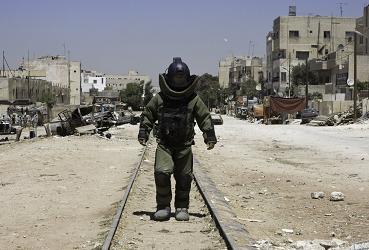The Hurt Locker is not about Iraq, why we went there, what we did when we got there, or whether we should have gone in the first place. It is not about American foreign policy or domestic disagreement over that policy; it’s not even about soldiers or their qualities or character … it’s not about politics at all.
The Hurt Locker is about an adrenaline junkie who gets off defusing bombs.
Sgt. Will James is very good at this narrow work. He is occasionally a fool who takes unnecessary chances. Far more often he is an expert who enjoys that his wisely bold tactics occasionally make him appear a fool–because a fool’s luck has nothing to do with his success. Early in the picture and after much prodding, Sgt. James admits to a superior officer that he has defused “873 bombs, counting today.”
Nobody’s luck is that good.
This is a telling scene for another reason: He’s happy for the recognition, but painfully shy about it, too. He fairly leaps from the truck to reply to the officer–but it’s because his inquisitor is an officer, not because the question will give him a moment of glory. The officer, played by the always interesting David Morse, has to pry the information out of him and turn it into a boast on Sgt. James’ behalf. Morse’s officer is so unabashedly enthusiastic with his praise that we’re not sure–and apparently neither is Sgt. James–if it is genuine, or a set-up to a dressing-down for the apparently insane risks he’s just taken.
The little-known (for now), Jeremy Renner plays Sgt. James, and he plays him like a guy who would enjoy solving a Rubik’s Cube while sitting on a high-wire over a pit of rabid alligators. Renner’s James is incapable of simply existing. Every moment must be a deadline or the run-up to some test. In his off-hours he plays punch-out with another soldier, and not just for the sake of taking a punch. The two are working through a grudge right out in the open. He creates a brief mission for himself that can have no benefits in its outcome aside from having survived on the quality of its execution. He looks for reasons to get next to live bombs, once on the pretext of rescuing a pair of entirely disposable gloves. Yet even this has more danger attached to it than anyone first thinks, but Sgt. James knows (at least, I think he does), and gets off on the errand all the more because of it.
The Hurt Locker is also a good-looking picture. For instance, the shots of explosions are carried out much more thoughtfully than with the standard “cover it with cameras” action-picture approach. Director Kathryn Bigelow (whose last great pictures were 20 years ago–Blue Steel and Point Break) shoots the gravelly ground rising in slow motion; she gets the shuddering and the debris exactly right (again, as someone like me who hasn’t seen this stuff for real will imagine they should look)–there is never an obvious, go-for-broke FX shot for its own sake here. At times our view of the explosions is mostly one-off detail, and rather than distracting us from the moment, it enhances how we perceive it. That is the purpose of good direction and good camera work: not to draw attention to itself, but to enhance the story.
Which is a little ironic, because The Hurt Locker is not a story at all, but a character study. It is rare that a character study is carried out with so much expert attention to making a truly engaging and entertaining picture. The Hurt Locker is an apolitical and very entertaining movie about a very interesting man.

COMMENTS
Please let us know if you're having issues with commenting.